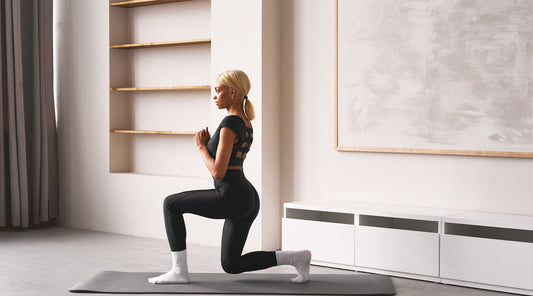Remote working certainly has its advantages. Still, we admit that bringing the laptop to the sofa (or even the bed) can be a bit too tempting. It’s easy to get a little too comfortable in the confines of your own home. But long days of slouching in front of a screen will inevitably catch up to you.
Creating a posture-friendly workspace at home can make a noticeable difference on your physical health, mental stamina, and job performance. Below, we discuss the key elements needed for an optimal workspace that will help you maintain good posture — and high productivity — throughout the day.
What Is a Posture-Friendly Workspace and Why Does It Matter?
A posture-friendly workspace allows you to sit comfortably while putting as little stress on your body as possible.
Poor posture may not only impact your health but the way you work, too. A lot of this has to do with your body’s efficiency. When it’s in proper alignment, it doesn’t have to work so hard. But if you’re spending long hours slumped over, you’re making your body work harder. This can cause neck and back pain, fatigue, headaches, and even reduced lung capacity, all of which will impact your focus and productivity.

Having a dedicated workspace that is designed with your comfort and posture in mind will help you work more effectively and efficiently.
Key Elements To Create a Workspace at Home for Posture Support
To create a posture-friendly workspace at home doesn’t require high-tech, top-of-the-line furniture. With a few adjustments to your current setup and perhaps a few key purchases, you can be sitting pretty — and way more comfortably.
If your work requires many hours at a computer, take a look at the chair and desk you use and the positioning of each. Your chair should provide good back support, your screen should sit at eye level, and the lighting in the room should be ample enough to help you avoid slouching and eye strain.
An Ergonomic Chair for Back Support
Your chair can be a simple piece but make sure that it provides lumbar (lower back) support. Lumbar support is meant to help maintain the natural curvature of the spine. Many office chairs already come with built-in lumbar support but there are also cushions or pillows that you can attach to any chair for better support.
Ideally, an ergonomic chair will also have adjustable features that allow you to change the height and armrests so that you can keep your feet flat on the ground and your elbows and wrists aligned with the keyboard. If you can’t adjust the height and your feet don’t quite reach the ground, you can always use a footrest or a stack of books to keep you grounded.
Make sure your chair is made with breathable materials and fits your style, too — the vibe of your space will also impact the way you feel in it.
A Desk Set at an Optimal Height
Your desk can also be a simple piece but it should be sturdy and provide you with enough space to comfortably work. Try to keep your desk clutter-free so as not to add unnecessary stress or distraction. If possible, invest in an adjustable desk so that you can switch between sitting and standing.
Whether sitting or standing, your desk should be at a height that allows you to keep your elbows and wrists in line with your keyboard and your screen at eye level. You can also use an ergonomic keyboard or laptop stand so that you can elevate your laptop to a height that encourages you to maintain good posture.
Proper Lighting to Avoid Slouching
The placement of your at-home workspace is also crucial when it comes to lighting. Poor lighting can result in increased slouching, as well as headaches, eye strain, and lower productivity (1). If possible, try to position your desk near a window to take advantage of natural light (which can also boost your mood!). Keep in mind that:
- South-facing windows get lots of sun exposure throughout the day.
- North-facing windows offer softer rays of sunlight.
- East-facing windows bring in the morning light. (Best if you like to work early in the day!)
- West-facing windows provide a warming afternoon glow.
Try to avoid direct light, which can cause glare, forcing you to strain your eyes while looking at your screen. Also, watch for shadows, which can have a similar disorienting effect. If you’re working late, opt for soft overhead lighting and a low-glare desk lamp with a swing arm or adjustable neck. Add some accent lighting (like LED strip lights or a wall sconce) to make your home office setup feel more homey.
How Posture Bras Help in Maintaining a Posture-Friendly Workspace
Even the best ergonomic workspace at home isn’t perfect. You can have everything perfectly positioned but, at the end of the day, you’re the one in control of your body. That said, there is one tool that can take a little of that pressure off of you: a posture corrector. Unlike a chair or desk, a posture bra works directly on your body to keep you in good alignment for long periods of sitting or standing.
Key Features To Look for in a Posture Bra
We believe that the Etalon Posture Bra is ideal for office wear, whether that office is on the other side of town or in your own home. When choosing a posture bra, there are some key features to look out for, including an ergonomic back support panel, breathable materials, and adjustable straps that allow for a custom fit. Ultimately, you want to make sure it’s comfortable and supportive enough to wear all day long.
Back Support Panel for Improved Posture
The centerpiece of the Etalon bra is the sturdy back support panel that works to keep your breasts in place as it gently tugs at your upper body, drawing your shoulder blades closer together and opening up your chest. This panel is connected to six adjustable straps.
Adjustable Straps for a Tailored Fit
Along with figuring out the right posture bra size for you, having the ability to customize the bra allows you to alter the fit, amount of support, and intensity of the posture-correcting pull. The Etalon bra has three different settings that can easily be changed according to your preferred comfort level.
Breathable Fabrics
Any type of functional apparel should be made with high-quality materials to prevent restriction of movement and skin irritation. The Etalon bra is made with lightweight, antimicrobial material that is breathable and moisture-wicking and offers four-way stretch for freedom of movement.
How To Maintain Good Posture Throughout the Day
Since good posture comes with such great benefits (Reduced pain! Better focus! Increased productivity!), creating a posture-friendly workspace should be a priority. Here are some key elements to keep in mind when putting together your home office space:
- A chair that provides lumbar support and is set at a height that allows you to keep your feet flat on the ground
- A desk positioned at a height that allows you to have your screen at eye level and your elbows and wrists in line with your keyboard
- Good lighting without glare (natural lighting is best)
- A comfortable posture bra that offers extra support
- Frequent breaks (at least once an hour)
- Regular movement (at least once an hour)
Along with an ergonomic chair/desk setup, good lighting, and a posture bra, you should be scheduling frequent breaks to rest your eyes and move your body. These 10 desk stretches are great for keeping you feeling good and on task.
SOURCES:
- City University London. “Lighting, Well-being and Performance at Work.” https://www.cass.city.ac.uk/__data/assets/pdf_file/0004/363217/lighting-work-performance-cass.pdf
FAQs
What are the most important elements of a posture-friendly workspace?
What kind of chair should I use to create a posture-friendly workspace at home?
How can I set up my desk to support better posture at home?
Do posture bras really help in maintaining good posture while working?
How often should I take breaks to maintain proper posture throughout the workday?
Are there any specific exercises or stretches I can do to improve my posture while working from home?
Trending
Try Etalon posture improvement products










